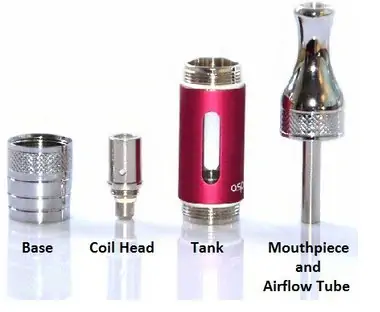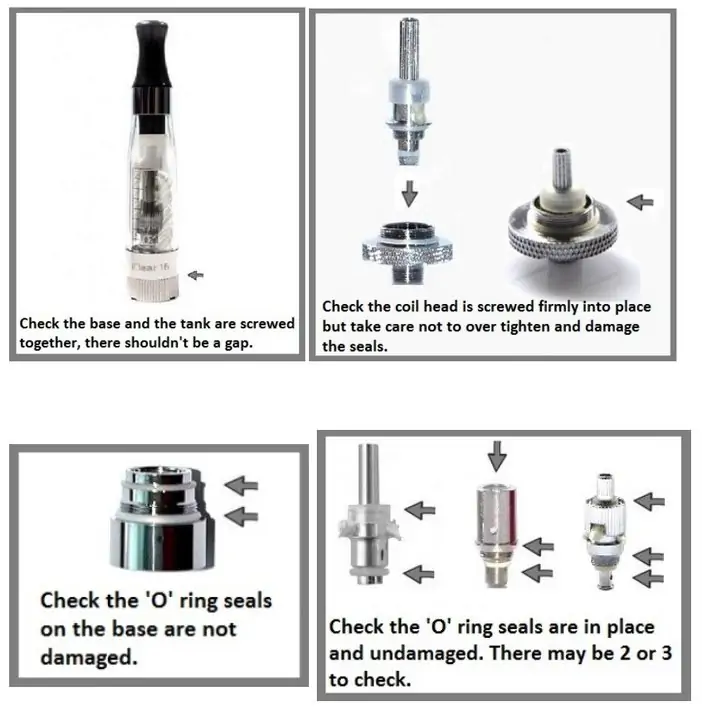Gurgles and leaks are common issues with e-cig devices and they can often be put right when you understand what might be causing the problem.
If you're using a sub-Ohm device (coils less than 1.0 Ohm) please go to the end of this article.
Leaking is often confused with flooding so if you decide you don't have a leaking tank please refer to our article e-cig tank flooded.
If you're simply hearing a gurgling noise (and it's not leaking), it may be because the device has been standing overnight and there's more liquid at the bottom of the coil making contact with the part that heats it up.
These are the different parts of a traditional tank:
The base - the bottom part which screws on to the battery.
Coil/atomizer head - within the base resides the part that heats up which is most commonly called a coil head or an atomizer head, and they're often referred to as coils.
Airflow tube - a small hollow tube which runs through the middle of the tank (sometimes this is part of the tank, sometimes part of the mouthpiece).
Tank - surrounding the central tube is the tank which may be metal, plastic or glass, and this is where the liquid is stored. When we refer to the tank it can also mean the whole thing, ie all the parts together. Sorry if that's a bit confusing.
Top - the top of the device may comprise more than one part, depending on the style, but one of these parts will be the mouthpiece where you draw and inhale from.

Things to be aware of to prevent leaking and gurgling
1. The central airflow tube needs to remain clear for air to flow through it. Good airflow is essential in order to vape properly. When filling, AVOID GETTING LIQUID IN THE CENTRE TUBE.
2. Everything needs to be screwed together firmly to prevent leaking but DON’T OVER TIGHTEN as this can break the seals.
3. Ensure the component parts are SCREWED TOGETHER STRAIGHT, NOT CROSS-THREADED or crooked.
4. The atomizer head can loosen when unscrewing the base so always secure the atomizer before reinstalling the base.
5. Keep the tank AS FULL AS POSSIBLE (DON'T OVERFILL) AND NOT BELOW 1/3 FULL of liquid. This helps to maintain the vacuum in the tank and prevent leaks.
6. Coils/atomizers have a limited lifetime. When they wear down, leaks are more likely along with diminished flavour and vapour.
7. It's normal to find a small amount of liquid (and condensation) in the battery contact area – best practice is to clean and ensure the battery is dry before charging it.
8. Sometimes these problems can be caused by poor design or workmanship, however it is relatively easy to ruin the ‘O’ rings seals by over tightening or not installing the atomizer properly. ENSURE THE 'O' RING SEALS ARE INTACT and that none are missing.
9. If your tank worked initially and now it's leaking, the problem is most likely to be a damaged seal or bad coil (most coils have a typical life of 1-2 weeks).
10. It is possible, although less likely, leaking can be caused by the battery connection or even the liquid. Different manufacturers have different tolerances so there could be as much as 1mm difference between the battery threading and the tank. This extra space can push up the atomizer or centre pin in the tank causing just enough space to cause leaking. You can check this by screwing the tank on the battery and then unscrewing half a turn. In some cases this can stop leaking immediately.
11. In more rare cases the liquid and voltage/Ohms can be a factor due to excess heat and/or how the liquid responds to heat. For example when the liquid gets thinner as it’s heated it may seep out where there might not have been a leak before. To test for this stop vaping, clean the tank connection (the base where it meets the battery) and then take one vape and leaving it for 30 seconds and repeat for a while, if it has stopped leaking, it is your voltage/Ohms and or liquid combination.
12. Above the coil and wick there is often a liquid sheath (like a plastic cover) this sheath protects the inside of the cylinder from getting liquid in it. It’s designed so that the coil will wick the liquid up to the coil and it will not get beyond where it's supposed to go. This generally works well but this is something to be aware of.
What to do when gurgling happens
Gurgling noises can be an indication that liquid has found its way into the centre tube and most often occurs after a refill. The gurgling is caused by the liquid mixing with air, a bit like when you suck through a straw when the glass is nearly empty.
To try and explain gurgles further, once a stream of water has been created, more will follow more easily, it already has a wet path to seep into. e-Liquid works in much the same way, and as it’s thicker/more viscous it will eventually flow more easily because it doesn't dry up. As e-liquid doesn't evaporate and it’s sticky it will remain near the lip and on the sides of the air flow tube until it's removed.
1. Remove the tank from the battery - taking care to turn it sufficiently upside down to stop the liquid running out as you remove the battery.
2. Wrap a paper towel around the battery end of the tank while its upside down and blow through the mouthpiece - again without turning it upright and spilling liquid.
3. The excess liquid in the central air flow tube will come out onto the paper towel as you blow. You may need to blow a few times to ensure the tube is clear.
4. Gurgling sounds can also occur when liquid reaches the battery connection. If you think you have this problem it sounds like flooding so please use the link at the top of this page for e-cig tank flooded.
What to do when leaking happens
1. Ensure the base and the atomizer are on nice and tight (but not too tight), and straight. Sometimes atomizers get put on slightly crooked which will cause leaking. Simply remove the atomizer head and screw/twist it back on.
2. Generally it requires very little effort to install the atomizer into the base, so be sure not to over tighten it and risk damaging or breaking a seal. Check to make sure the 'O' ring seals are not broken.
3. Ensure the base is on properly and there’s no gap between where the base and the tank join together.
There are many different coils and tanks but these images will give you an indication of what to look for and check in order to resolve issues.

Cracked e-cig tanks
If liquid is leaking from the outside of the tank (usually from the base) then look for small cracks, if there are cracks, this is a leaking tank and you will need a new one.
Cracks in tanks can occur for difference reasons, the heat itself can cause plastic tanks to crack (they can melt in some cases) but some juices are much more prone to cause cracking than others, here are a few examples: Menthol, spearmint, absinthe, cinnamon, citrus fruit flavours, cola.
Glass tanks are ideal and perfect for all e-liquids if you think your liquid is causing the problem
Change of temperature can affect e-cigs Just be aware that temperature can contribute to problems. When you’re outside and your e-cig gets cold, the air, liquid and components within it contract and more air can enter the system. When you’re indoors or somewhere warm, as your e-cig, liquid and component parts warm up again, the air expands and the liquid comes under more pressure.
Use a bowl to wash your tank.
DON'T WASH YOUR TANKS IN THE SINK BECAUSE YOU ARE LIKELY TO LOOSE YOUR SEALS DOWN THE PLUG HOLE!
Irregular use can cause some tanks to leak
Some tanks are much more prone to leaks if they’re not in regular use. If you’re not going to use one for a while, best to empty it and refill it when you need it. When in regular use, the liquid tends to be vaped away before it has a chance to run out and an old atomizer will increase the chances of leaks occurring.
More tips
You may find letting your e-cig rest for 30 mins or so after you've finished with it stops the odd drips that can occur when you unscrew them immediately after vaping and put them straight away.
Sub-Ohm tank leaking, gurgling, spluttering
If you’re using a sub-Ohm tank and coils (sub-Ohm means coils with a resistance of less than 1.0 Ohm) and you’re getting liquid in the mouth, or liquid leaking out of airflow slots, etc, this example of what not to do with the likes of the Eleaf Melo may prove helpful.
Firstly, ensure the power (ie the wattage or the voltage) is in the correct range for your coil.
You need to ensure the power setting isn't too low and your e-liquid isn't too thin.
In the case of the Melo 0.5 Ohm coils it’s probably circa 25W. The Melo is designed to match the Eleaf iStick 30 mod which has a range of 5-30W but if you set the wattage too low the liquid cannot vapourise, and instead it will gurgle away, perhaps get darker in colour, and you’ll end up with it in your mouth or seeping out wherever it can because it has nowhere else to go every time you press the fire button.
You also need to use a good quality e-liquid with more VG than PG (VG is thicker than PG and produces a lot more vapour).
Be aware that 6mg (0.6%) nicotine is probably an absolute maximum strength e-liquid to use with many sub-Ohm coils.
If you can’t take the hit from the increased vapour from the VG content of the e-liquid, turning the power down will cause more problems than it solves, instead you need to reduce the nicotine strength.
In addition to this, when you press the fire button you need to inhale directly into the lungs (“lung it”). Sub-Ohm vaping, which usually has a looser, more airy draw, is designed for direct lung inhale, as opposed to the more traditional mouth to lung inhale.
For further information click here for our article about the best e-liquid for different e-cig coils.
Nautilus 2 Tank - example of an issue
I thought I'd record this as a good example of severe leaking. It was a brand new item, before filling and priming the coil I checked it was screwed right in and everything was fitting together as it should be. On filling the tank the juice leaked through and came out the airflow holes at the base, did that a couple of times. I changed the coil and it did it again. Three times I checked and dried everything. On the third or fourth time of filling suddenly it was working perfectly. Although I couldn't see the problem, the fact that the liquid could trickle through and out as it did means that something wasn't sealing as it should, there was an unplanned path for that liquid to flow. A little bit of patience and I worked through it, but it was puzzling at the time.

